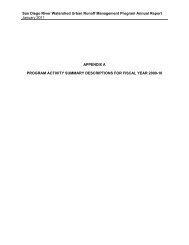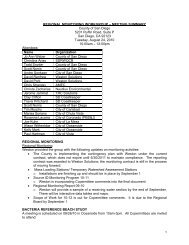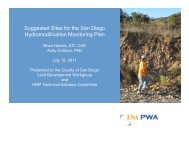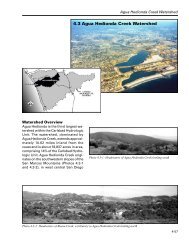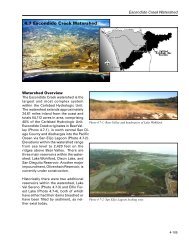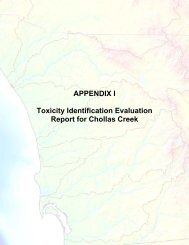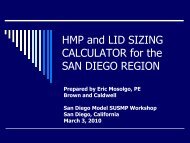APPENDIX I Toxicity Identification Evaluation Reports for Chollas ...
APPENDIX I Toxicity Identification Evaluation Reports for Chollas ...
APPENDIX I Toxicity Identification Evaluation Reports for Chollas ...
Create successful ePaper yourself
Turn your PDF publications into a flip-book with our unique Google optimized e-Paper software.
<strong>Toxicity</strong> <strong>Identification</strong> <strong>Evaluation</strong> of <strong>Chollas</strong> Creek<br />
Stormwater using Hyalella azteca<br />
Results<br />
August 2006<br />
The pH 6.8 manipulation did not reduce toxicity in the 100 percent sample concentration (46.7%<br />
survival) relative to toxicity in the unmanipulated Baseline test (53.3% survival in the 100<br />
percent sample concentration). Survival in the pH 6.8 treatment blank was 100%. This<br />
indicates that the causative agent was not a pH sensitive chemical such as ammonia.<br />
The 0.025 mg/L PBO treatments led to increased toxicity in the 100 percent sample<br />
concentration (0% survival) relative to toxicity in the unmanipulated Baseline test (53.3%<br />
survival in the 100 percent sample concentration). Survival in the 0.025 mg/L treatment blank<br />
was 86.7%. The 0.050 mg/L PBO treatments also led to increased toxicity in the 100 percent<br />
sample concentration (13.3% survival) relative to toxicity in the unmanipulated Baseline test<br />
(53.3% survival in the 100 percent sample concentration). Survival in the PBO 0.050 mg/L<br />
treatment blank was 66.7%. The increase of toxicity in these manipulations suggests that<br />
pyrethroids may be a causative agent in this stormwater sample. Specifically, it is well-known<br />
that sublethal concentrations of PBO potentiate the toxicity of pyrethroids (Budavari, 1989).<br />
A reference toxicant test was conducted using PBO with concentrations of 0.01, 0.05, 0.1, 0.5,<br />
and 1 mg/L to verify that the concentrations of PBO used in the Phase I TIE were at sublethal<br />
levels. The calculated 96-hour LC 50 was 0.41 mg/L. The NOEC (0.1 mg PBO/L) was above both<br />
concentrations of PBO manipulations used to evaluate the stormwater sample. This indicates<br />
that PBO alone is most likely not a factor in any of the observed toxicity.<br />
The carboxyl esterase treatment reduced toxicity in the 100 percent sample concentration<br />
(86.7% survival), relative to toxicity in the unmanipulated Baseline test (53.3% survival in the<br />
100 percent sample concentration). Survival in the carboxyl esterase treatment blank was 80%.<br />
In contrast, the BSA treatment did not reduce toxicity in the 100 percent sample concentration<br />
(66.7% survival), relative to toxicity in the unmanipulated Baseline test (53.3% survival in the<br />
100 percent sample concentration). Survival in the BSA treatment blank was 100%. These<br />
data indicate that the chemical(s) responsible <strong>for</strong> the observed toxicity were not just adsorbing<br />
to binding sites on proteins (BSA or carboxyl esterase), but were enzymatically altered by the<br />
carboxyl esterase.<br />
A copper sulfate reference toxicant was tested at nominal concentrations of 62.5, 125, 250, 500<br />
and 1000 µg Cu 2+ /L. The calculated 96-hour LC 50 (195.62 µg Cu 2+ /L) was within two standard<br />
deviations of the laboratory mean (356.12 µg Cu 2+ /L) at the time of testing. This indicates that<br />
the sensitivity of H. azteca used in this evaluation fell within the normal range.<br />
4.1.6 Summary of TIE per<strong>for</strong>med on January 2, 2006 Sample<br />
Results from the TIE per<strong>for</strong>med on the <strong>Chollas</strong> Creek stormwater sample collected in January<br />
provided additional evidence that pyrethroids were likely responsible <strong>for</strong> the observed toxicity.<br />
In accordance with the October TIE, there was a lack of toxicity reduction in the EDTA, STS,<br />
graduated pH, and aeration treatments, which indicates that the causative agent was likely not a<br />
metal, an oxidative chemical, a pH-sensitive chemical, or a volatile chemical or surfactant,<br />
respectively. However, the reduction in toxicity of H. azteca following filtration of the stormwater<br />
sample indicates that the causative agent was highly bound to particulates in the sample.<br />
These results support the evidence provided by the October TIE which indicate that the<br />
causative agents have similar physicochemical properties to those of pyrethroids. Also similar<br />
to results of the TIEs per<strong>for</strong>med in October and November of 2005, PBO treatments led to<br />
increased toxicity in the undiluted stormwater sample. The repeated potentiation of toxicity using<br />
PBO in all recent TIEs provides strong evidence that pyrethroids are the causative agents,<br />
Weston Solutions, Inc. 20







